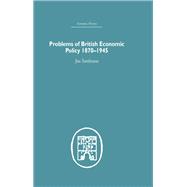
Note: Supplemental materials are not guaranteed with Rental or Used book purchases.
Purchase Benefits
What is included with this book?
| Acknowledgements | p. v |
| Introduction: Approaches to economic policy | p. 1 |
| Unemployment as an object of policy before 1914 | p. 13 |
| Britain and the gold standard 1880-1914 | p. 26 |
| Trade and Empire before 1914 | p. 44 |
| Unemployment as an object of policy in the 1920s | p. 62 |
| Public Works, We Can Conquer Unemployment, and the Treasury View | p. 76 |
| The problem of $4.86 | p. 92 |
| The Empire and British economic policy after 1914 | p. 106 |
| British economic policy 1931-45: a Keynesian revolution? | p. 120 |
| Notes | p. 135 |
| Name index | p. 157 |
| Subject index | p. 159 |
| Table of Contents provided by Ingram. All Rights Reserved. |
The New copy of this book will include any supplemental materials advertised. Please check the title of the book to determine if it should include any access cards, study guides, lab manuals, CDs, etc.
The Used, Rental and eBook copies of this book are not guaranteed to include any supplemental materials. Typically, only the book itself is included. This is true even if the title states it includes any access cards, study guides, lab manuals, CDs, etc.